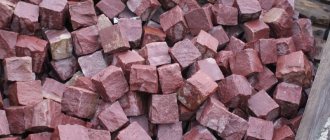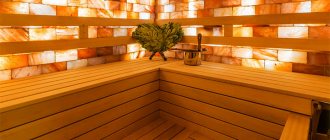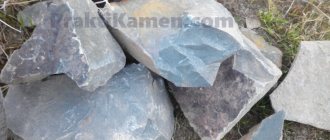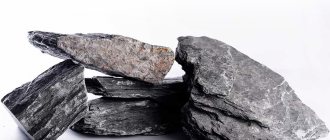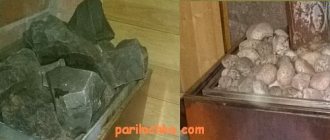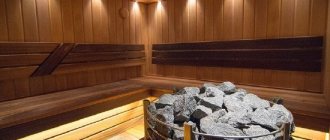Main characteristics of quartzite.
Radioactivity
: According to the results of gamma spectral studies, the specific effective activity of natural radionuclides in quartzite samples is 88-194 Bq/kg, which does not exceed the standard value for class 1 building materials.
Let's summarize. Quartzite is not any specific stone. And this is a group of types of stones that are characterized by a high content of quartz (70-98%). Thanks to this characteristic on the wiki, many marketers began to write that crimson quartzite contains 98% quartz. I have already expressed my position on this stone in a separate article.
The quartzite family includes many stones such as Ferrous, Raspberry, and Romanov quartz. For baths they also sell White quartzite - ordinary quartz with a large admixture of other substances. It is mined together with quartz.
Criteria for choosing stones: which stones are best suited for a bath?
The most important characteristics that stones for baths and saunas should have include:
Why do experts recommend purchasing certified and already packaged products, rather than collecting the first river stones you come across for a bath?
Acting this way without having experience and special knowledge of geology is very dangerous. Constant and significant temperature changes in the steam room can destroy even stone. And if you have collected unsuitable stones for the stove in the bathhouse, they can split when heated, shooting out fragments, which can lead to serious injuries.
But that’s not so bad. Many minerals emit toxic gases when heated, and stones of organic origin saturate the generated steam with harmful microelements. As a result, under no circumstances use stones for baths and saunas whose properties are unknown to you.
In addition to all of the above, the quality of steam is also influenced by the size and appearance of the stones. Pay extreme attention to the arrangement of the backfill itself.
A good heater on the stove:
For electric furnaces, you need to select medium-sized stones. For wood-burning analogues, choose a combination - medium and large backfill.
Another circumstance is that round stones heat up more evenly, and air circulates between them more freely. But it is worth noting that the best stones for a bath have slight irregularities and roughness. Water does not bounce off their surface, but evaporates gradually.
It is worth noting that all experts agree that the best types of stones for a steam room are volcanic. The logic here is simple - since they underwent the action of gigantic temperatures of the Earth’s magma during formation, then they will withstand bathing procedures calmly.
Let's take a closer look at the stones for the bath: which ones are best to purchase.
Quartzite for Bath.
As a rule, quartzite has the same properties as quartz. The “fast” stone has the same heat capacity as quartz (0.75 kJ), and has the same disadvantages - service life. But what it did not inherit from quartz is that it is not so enriched with oxygen.
Oxygen molecules react with quartzite impurities. If the connections are strong, then when heated you will not get the ozone effect from quartzite, but quartz will always give it to you.
In general, quartzites combine quite well with other stones in a heater. The only thing is that if you only lay it up, down and closer to the stove - there is no point. It doesn't have the same heat capacity. And the service life will also noticeably decrease.
Connoisseurs noticed that there is also Jasper in the photo. We’ll find out why I added it here in the following articles.
Benefits and properties of crimson quartzite
Firestones in a bathhouse perform a number of important functions, the main one of which is the constant accumulation and release of heat to maintain a consistently high temperature. An equally important property of firestones is hardening and resistance to high temperature changes (when exposed to high temperatures, the stones do not become cracked or chipped).
The optimal choice for baths and saunas are stones made of volcanic and igneous rocks, which meet all of the above requirements and are affordable. For masonry, stones without cracks and chips with a diameter of 5 to 25 cm are selected, which can last a long time without losing their characteristics.
Note!
For a bathhouse, it is necessary to select stones of the appropriate size. For an electric heater, medium ones are optimal; for a traditional wood-burning stove, large and medium ones are optimal. The stones should have a rounded shape with slight irregularities on the surfaces, which ensure the gradual evaporation of water from the surface.
Crimson quartzite is a metamorphic rock (formed from solidified magma, subsequently changing its properties under the influence of pressure and temperatures). Quartzite is an environmentally friendly rock that consists of 95 percent quartz.
Quartzite for bathhouses is mined from deposits in Karelia on the coast of Lake Onega. The rock does not contain foreign impurities, and the unique composition of the stone provides unique strength and hardness. The rich, bright crimson hue of quartzite is given by hydroxides and iron oxides.
The main properties of crimson quartzite include:
- The fine-grained, homogeneous structure of the rock ensures uniform expansion of quartz grains, which makes it resistant to repeated heating and cooling.
- The rock has no internal stress, making it resistant to external mechanical stress and destruction. Rapid heating to high temperatures and cooling are not harmful to quartzite.
- The high heat capacity and low thermal conductivity of the stone make it a universal finishing material for a bathhouse (it “gains” and releases heat over a long period of time).
- An environmentally friendly facing material, unlike granite, quartzite for a bathhouse has low radioactivity (when heated, the rock does not emit harmful toxic substances, which is why it is widely used for finishing heaters, internal and external cladding of buildings/structures).
- The result of machining. The rock is difficult to process, but after grinding it acquires an aesthetic appearance. Due to its special structure, quartzite is not sawed, but split, so it does not have sharp corners or chips.
Raspberry quartzite for baths is a semi-precious finishing rock. Due to its unique spring appearance and high aesthetic characteristics, the stone is called royal. It can withstand temperatures up to 1600 degrees, and during intensive use it retains its characteristics and properties for a long time.
Long service life, fast heating and good heat dissipation make crimson quartzite a universal finishing material for baths and saunas. When choosing a high-quality facing stone, you need to pay attention to the presence of chips and cracks, and during operation, regularly check them to identify them in a timely manner.
Raspberry quartzite - indications and contraindications
Having studied the properties of raspberry quartzite for a bath, you should also be aware of the contraindications. Some people do not tolerate high humidity and temperature in the bathhouse, which affects the heart and blood vessels. It is impossible to say unequivocally that crimson quartzite, a bath stone, has a negative impact. But no one canceled the precautions when visiting the steam room.
Using quartzite in a bath
Raspberry quartzite retains heat for a long time and produces light, soft steam, which makes it versatile for a bathhouse. The environmentally friendly mineral has invaluable benefits for the human body, thanks to its special chemical composition and healing properties:
- Normalization of blood pressure.
- Strengthening the immune system.
- Improving blood composition and microcirculation.
- Elimination of weakness, malaise and other signs of changing weather.
- Relief from pain in muscles, joints, and lumbar region.
Raspberry quartzite is popular for baths and saunas, since its use allows you to “fight” various diseases (attacks of rheumatism, colds, painful sensations in joints and muscles, and a general strengthening effect on the body). The use of crimson quartzite improves the health and general well-being of bath attendants.
Processed and polished crimson quartzite has unique decorative characteristics. It is widely used for the exterior decoration of wood-burning and electric stoves, baths and saunas, as well as other buildings and structures.
Note!
The main disadvantage of crimson quartzite is its low resistance to open fire. For use as firestones for baths and saunas, a mixed backfill of rock is used. When the laying is closed, large, inexpensive stones are placed on the bottom, and small, expensive ones (jadeite, jade) are placed on top. Open laying of stones in a furnace is subject to less exposure to open fire; crimson quartzite is ideal for such filling.
Gray quartzite
This type of crimson quartzite is recognized as the most common. Area of application: meditation in warmth (for example, in a bathhouse). According to practitioners, it allows you to relax and “get to know” yourself.
White quartzite for a bath is the best option
Before using white quartzite, its properties are studied in detail. Thus, the material is highly fire-resistant and resistant to prolonged exposure to high temperatures.
| Physico-mechanical properties of white quartzite | |
| Compound: | silicon oxide SiO2 |
| Compressive strength: | 100-400 MPa |
| Density: | 2.6 g/cm3 |
| Fire resistance: | up to 2000 degrees |
This allows it to be used in the construction of stoves, as well as in the manufacture of other objects and products used in close proximity to open fire. In terms of strength, quartzite is the undisputed leader, second only to corundum and diamond. In the absence of a center of symmetry of the crystal lattice in this material, mechanical compression can lead to the appearance of microelectric discharges, the so-called “piezo effect”. This is exactly what happens when water gets on hot cobblestones. As a result, ozone is formed, which, when released, fills the steam room. The purity of the material also has its own characteristics. Therefore, strong and heat-resistant white quartzite for a bathhouse is an excellent option. Easily withstanding temperatures up to 2000 degrees Celsius, the material does not lose its valuable qualities. When used in heaters, the stone exhibits its most important properties: it combines unique heat capacity with the ability to retain heat for several hours.
The stone can be used in a bathhouse for up to a year, after which it is replaced with a new one.
White quartz and its features
White quartzite for baths is found everywhere, the special properties of which make it possible to use it in rooms with high temperatures and humidity. Water falling on the hot cobblestones in the steam room causes microelectric discharges, and ozone, which is very beneficial for health, is formed. A “piezo effect” occurs.
History and origin of the mineral
Quartzite is formed from sandstone, the basis of which is quartz.
Under the influence of high temperature and pressure, sandstone combines with mica, talc, spar and other igneous rocks. This combination is particularly durable and fire-resistant. The primitive tools of ancient people found at excavations are made of quartzite. Stone processing was then minimal - a person took the most suitable piece of shape and hewed it against other stones.
In subsequent centuries, the mineral was used for architectural purposes for a long time:
- Napoleon Bonaparte's sarcophagus was made from it;
- tomb of Alexander II;
- roof of the Mausoleum;
- facing of the Church of the Savior on Spilled Blood.
Nowadays the stone is used not only by architects, but also by jewelers.
Why do you need quartzite in a bathhouse?
Judging by the reviews, crimson quartzite for baths is in wide demand due to its physical and aesthetic qualities. Using stone in a sauna stove makes steam very light due to the low thermal conductivity and high density of the mineral. The combination of these qualities guarantees good heat transfer for a long time.
It is not without reason that the mountain mineral is used as a filter that purifies water: it is believed that this improves its taste.
Among the disadvantages inherent in the mineral, the first one is its high cost. Not every bathhouse owner can afford it. Despite its long service life, the mineral still deteriorates over time and at the same time crumbles into small sharp elements. Therefore, when inspecting the heater, you need to arm yourself with thick gloves so as not to damage the skin.
Quartz bath stones and their varieties are very valuable for the body. They have found application in the external arrangement and interior decoration of the bathhouse, and are used as stones in the steam room. High decorativeness, long service life and environmental safety are the main advantages that will recoup the cost of purchasing the stone in just a couple of years.
Quartz production
In natural, natural conditions, a large amount of the mineral is mined. But, despite this circumstance, several methods for the artificial production of quartz have been developed and patented. One of them is the hydrothermal method.
Experts in the field of mineralogy claim that the mineral obtained artificially has a homogeneous composition, the impurities of which are evenly distributed in it, better than natural quartz.
Piezo-optical rock is artificially created. This gem is used in the production of gold and silver jewelry, since a stone of any shade and the required color saturation can be obtained artificially.
The largest enterprises for the production of artificial minerals in our country are located in Gus-Khrustalny and Yuzhnouralsk. The Gusev Crystal Factory named after Maltsov operates in the city of Gus-Khrustalny. In Yuzhnouralsk, Ural quartz is produced at a plant that has been operating since the times of the Soviet Union, since 1962. Here, under Soviet rule, a mineral necessary for the needs of the radio-electronic industry was produced; part of the artificially bred rock was sent for export. Another enterprise in the Southern Urals is PJSC Quartz, which produces sheet glass, crystal and products made from it on a large scale.
Positive characteristics of quartzite
In nature you can see quartzite of different shades:
- black or gray;
- orange or yellow;
- raspberry or red.
Taking into account the reviews of experienced bathhouse attendants, it is best to choose a crimson-colored mineral for a steam room or sauna. This type of quartzite, with reduced thermal conductivity, has a fairly high density, so the heat transfer of the mineral increases several times.
In addition to the above properties, it has long been noted that it is the raspberry mineral that has a beneficial effect on the health of everyone who takes bath procedures. IN
In particular, the stone helps with the following:
- reduce the discomfort that a person experiences during sudden changes in weather conditions;
- normalize blood pressure;
- relieve joint pain;
- clear the airways;
- normalize metabolism.
Those who have enjoyed bath procedures with crimson quartzite stone more than once have noted that not only their well-being improves, but also their sleep patterns improve. Therefore, you should not even think about whether you need to use this unique mineral in your own steam room or use another type of rock. The answer to this question is clear - those who want to get therapeutic and very effective results from bathing activities should definitely take care of the presence of crimson quartzite in their own steam room.
Types of stones for baths
The following minerals are suitable for loading into the sauna stove container: jadeite and crimson quartzite, porphyrite and gabbro-diabase, peridotite and white quartz, jade and wax jasper, dunite and basalt, chromite and talc (soap) stone. Each of them has its own characteristics and features, which we will discuss below:
- Jadeite
. Tops the list of the best stones for a bath. This opaque green mineral is durable and safe, releases heat slowly, and its high density allows it to withstand not only strong heating, but also temperature changes. Thanks to this, the jadeite stone for baths does not crumble, does not crack and is ideal for long-term use. Its price is quite high, so the mineral is placed on top of other stones of cheaper rocks to maximize its healing properties. Their range is quite wide: it treats blood pressure disorders, normalizes heart function, optimizes blood structure, strengthens the nervous system, dissolves salt deposits, reduces rheumatic discomfort, heals the genitourinary system and increases the energy of the whole body. - Raspberry quartzite
. It has a wonderful purple color that will effectively decorate the interior design of any steam room. This stone is incredibly fire-resistant and dense, able to withstand heat up to 2700 degrees. It is durable and reliable. The strength of crimson quartzite makes it difficult to machine, so it is supplied in chipped form. The mineral does not crack; when it is heated, even cold water can be poured onto the heater. Like jadeite, quartzite bath stone is laid on top of the main stones. Its healing properties can cure muscle pain, attacks of rheumatism and colds. Raspberry quartzite normalizes blood pressure, the circulatory system and removes salt deposits in the body. - Porphyrite
. It is not very popular among bathhouse lovers, but this is wrong. Its affordable price makes the mineral accessible to the vast majority of bathhouse owners. Porphyrite has an enviable heat capacity and fragrant steam at the exit. Its initial heating is accompanied by a crackling sound, but there is no need to worry - with repeated heating it disappears. The stone has a beneficial effect on the functioning of the heart and respiratory system, relieves skin inflammation and headaches. - Gabbro-diabase
. Refers to minerals of volcanic origin. It has a grainy structure, incredible density and a dark marble color. The stone is supplied in crushed form from Karelia, which is an ecologically clean natural area. Long-term heat gain and rapid cooling without heating are the disadvantages of this material. At high temperatures, gabbro-diabase emits a specific odor; tinctures and essential oils cannot be used on its stones - carbon deposits from them form instantly. The mineral is subject to cracking, its service life is 2 years. But due to the low cost of the stone, this is unlikely to upset anyone. The healing properties of gabbro-diabase are modest, which is why it is laid down under stones that are more beneficial to health. This helps to enhance the healing power of natural healers significantly. - Peridotite
. Attracts attention with the variety of its shades - from green to rich black. It does not contain harmful impurities, the mineral evenly radiates heat when heated. When it enters into a chemical reaction with carbon dioxide, steamed peridotite disinfects and purifies the air. It is placed on the bottom of the heater under more valuable rocks. - Translucent white quartz
. Externally very impressive. It contains silicon and oxygen. Thanks to the latter, after sharp cooling, the mineral releases pure ozone, which has a rejuvenating effect. Quartz helps restore the epidermis layer and cleanses the breath. The healing effects of the mineral are noticeable even a few days after the procedures. This stone is not durable at high temperatures - it may even burst. Therefore, quartz is often reprocessed, removing specimens damaged by the heat of the heater. - Jade
. Has high strength steel. It is almost impossible to break it into pieces by hand. It is not without reason that in ancient times various tools and tools were made from it. When using jade stone for a bath, the body's metabolism, the condition of its nervous and muscular systems, skin and sweating improves. Jade treats insomnia, stress and relieves fatigue. - Wax jasper
. It has long been used in baths by wealthy people, as it is a semi-precious stone. When used in heaters, the mineral shows excellent characteristics. The use of jasper in folk medicine helps in the treatment of the heart and internal organs. The mineral is suitable for healing mental and women's diseases. Jasper will be needed for insomnia, to stop bleeding and heal wounds. - Dunit
. Does not contain radiation emissions and harmful impurities. It is resistant to destruction from temperature changes in the heater. The excellent thermal conductivity of the mineral contributes to the rapid release of its heat, and its high heat capacity contributes to its long-term preservation. Only dunite has this unique feature. The mineral is beneficial for the cardiovascular and nervous system, it treats colds and lowers blood pressure inside. - Basalt
. It is black in color and is the most durable volcanic rock of all that are used in baths. It has good heat capacity and performs well when heating and cooling to create steam. The mineral is durable and does not contain harmful impurities. Hot basalt produces intense and long-lasting steam. This is one of the types of stones that please with its price. - Chromite
. Most common in Russian baths in the Urals. There it became known as the “black bath stone”. Its thermal expansion coefficient at high mineral density is relatively low. Chromite is not subject to cracking and has no harmful effects on the body in the form of radioactive radiation. Traditional medicine uses this mineral to treat colds. - Soapstone chlorite
. “Soapstone,” as it is also called, is a fairly durable mineral with good thermal conductivity. It has an attractive appearance with a variety of gray shades and provides the creation of “soft” steam in the steam room. The mineral is very resistant to alternating heating and rapid cooling. When heated, the soapstone chloride for the bath emits enzymes that have a beneficial effect on the body’s metabolism and its immunity. It stimulates metabolism, normalizes blood pressure, treats internal inflammatory processes and colds.
What are its benefits?
Of course, quartzite began to be used as a stone for baths precisely for its beneficial properties, which, perhaps, only the lazy do not talk about.
- helps well in the fight against rheumatism;
- perfectly eliminates pain in muscles and joints;
- regulates blood pressure;
- cures colds and strengthens the immune system;
- normalizes metabolism in the body.
Of course, these are not all the beneficial qualities that are usually mentioned in connection with the use of quartzite for baths.
The vast majority of people are also talking about stronger and healthier sleep - and just a general improvement in their well-being. Of course, you shouldn’t “blame” the royal stone alone for this: bath procedures, when properly organized, have no less a positive effect on the body, even if completely different rocks are used for kindling. If you often have a headache after a bath, then try quartzite: perhaps this is what will help you avoid the sad tradition.
How to properly arrange the rocks in the heater?
How to properly lay stones in a heater
For a high-quality “steam room” it is necessary to correctly distribute the stones, creating favorable conditions for the passage of hot air.
Before starting laying work, the stones are washed thoroughly and dried.
Preparing stones for laying in the heater
Do not neglect this point, because later you will have to breathe this air. We stack according to the principle: first the large ones, then the small ones. When dealing with oblong stones, place them vertically, so they will heat up faster.
How to lay stones in a sauna stove
When working with an electric stove, when laying it, it is important to leave gaps between the stones and the tubular electric heaters. This installation method will prevent damage to the heating elements. When heated, the stones expand, which can cause the tubes to break.
Laying stones in an electric floor oven
Several times a year it is recommended to carry out an “audit”: inspect the contents of the heater for cracks, chips, deposits and replace them regularly.
When choosing stones to fill a heater in a sauna, you should be guided not only by their appearance, but also by their high heat capacity and resistance to temperature changes, which have a positive effect on increasing the service life. Possession of useful qualities of stones that have a beneficial effect on human health will give a pleasant pastime in the bathhouse a healing character.
Briefly about the main thing
The main properties of stone for a bath are heat resistance, the ability to store heat and not absorb moisture, density and uniformity of structure.
- Jadeite is an expensive and rare stone that has a healing effect on the human body.
- Soapstone is a northern stone often used for saunas.
- Crimson quartzite is a beautiful brown stone that is resistant to high temperatures and produces high-quality steam.
To lay the heater, you can use gabbro-diabase, white quartz, sea pebbles, and basalt.
You can find some types of bath stones yourself. But you shouldn't do this on a railway embankment.
You need to place stones in the heater, placing them on the bottom. At the bottom there should be the most massive specimens and the most heat-resistant rocks.
It’s not enough to know how to choose stones for a bath; you also need to carefully care for them. Be sure to wash them and periodically replace damaged ones.
Criteria for choosing stones: which stones are best suited for a bath?
The most important characteristics that stones for baths and saunas should have include:
- uniformity;
- good heat capacity;
- strength;
- no toxic odors when heated;
- low level of water absorption.
Why do experts recommend purchasing certified and already packaged products, rather than collecting the first river stones you come across for a bath?
Acting this way without having experience and special knowledge of geology is very dangerous. Constant and significant temperature changes in the steam room can destroy even stone. And if you have collected unsuitable stones for the stove in the bathhouse, they can split when heated, shooting out fragments, which can lead to serious injuries.
But that’s not so bad. Many minerals emit toxic gases when heated, and stones of organic origin saturate the generated steam with harmful microelements. As a result, under no circumstances use stones for baths and saunas whose properties are unknown to you.
In addition to all of the above, the quality of steam is also influenced by the size and appearance of the stones. Pay extreme attention to the arrangement of the backfill itself.
A good heater on the stove:
- durable;
- heat-intensive;
- dense;
- resistant to temperature changes;
- the stones in it have optimal sizes.
For electric furnaces, you need to select medium-sized stones. For wood-burning analogues, choose a combination - medium and large backfill.
Another circumstance is that round stones heat up more evenly, and air circulates between them more freely. But it is worth noting that the best stones for a bath have slight irregularities and roughness. Water does not bounce off their surface, but evaporates gradually.
It is worth noting that all experts agree that the best types of stones for a steam room are volcanic. The logic here is simple - since they underwent the action of gigantic temperatures of the Earth’s magma during formation, then they will withstand bathing procedures calmly.
Let's take a closer look at the stones for the bath: which ones are best to purchase.
Gabbro-diabase
Gabbro-diabase stone is similar to marble or granite
This volcanic rock is similar to marble or granite and is uniformly dark in color. It has high density, strength and low water absorption. When heated, gabbro-diabase expands evenly. In addition, these bath stones are mined in the most environmentally friendly corner of Russia - Karelia, and are inexpensive.
One of the disadvantages is that diabase takes a long time to heat up and cools down quickly. In addition, if these stones are heated strongly, they begin to emit a not strong, but specific odor.
The therapeutic effects of this breed have not been identified.
Soapstone chlorite
When heated, soapstone emits soft, comfortable warmth
This rock has a denser and more durable structure than diabase. Externally, soapstone bath stones are discreet, but interesting and have a variety of shades of gray.
The rock has good heat capacity and resistance to chemically aggressive environments.
The most important advantage of the stone is that it heats up extremely quickly. It accumulates 2.5 times more heat than a stove brick and releases it evenly and for a long time. This means that soapstone generates “light” steam.
Useful properties of soapstone:
Among the beneficial properties of the rock, it can be noted that when heated, it emits soft and comfortable heat, in the infrared spectrum, similar to the sun. It increases our immunity and normalizes metabolism.
When choosing which stones are suitable for a bathhouse, keep in mind that soapstone may generate dust. You will get rid of this drawback if you rinse and heat the stones before the first bath procedure.
Jade
Crushed and polished jadeite for baths
This semi-precious rock has an emerald or light green color and is not volcanic, but is a separate mineral.
In addition to their beautiful appearance, these stones for sauna heaters have the highest strength and service life (3 times longer than other types), low water absorption and high heat capacity. It is worth noting that jadeite stone for baths retains heat for a long time and generates very powerful steam. Jadeite is absolutely safe and environmentally friendly.
Jadeite colors range from light green to emerald green
Useful properties of jadeite:
Of its healing properties, the most important are the beneficial effects on the central nervous system, stabilization of blood pressure, cure of kidney and urinary tract diseases.
Karelian porphyrite
Karelian stones for baths are very popular - one of them is porphyry. It is mined on the shores of Lake Onega, located in the south of Karelia.
Karelian porphyrite is solidified lava
The heat capacity of the rock makes it possible to maintain high temperatures in the steam room for a very long time and thereby save fuel and electricity. According to this indicator, porphyrite is not inferior to expensive jadeite.
This rock is essentially solidified volcanic lava and contains elements that are resistant to physical and chemical attack. Basically, these are oxides of calcium, silicon, and magnesium. The stone contains absolutely no harmful radionuclides and no less harmful sulfur compounds.
As a result of all this, porphyrite is the best option for use in sauna and bath heaters. Among other things, it perfectly withstands constant sudden temperature changes, is not afraid of interaction with open fire, and does not crack or collapse when wetted with water in a heated state.
Useful properties of porphyrite:
The steam that these bath stones generate has healing properties. It can relieve headaches, stabilizes and equalizes our blood pressure, improves blood flow and has the most beneficial effect on the skin.
Soapstone chlorite
This type of natural materials is more durable compared to gabbro-diabase
If you have to choose which stone is better for a steam room bath, then it is recommended to pay attention to this option
Soapstone can have different shades of gray. Minerals do not look very attractive, but they have a good heat capacity - that is why stoves are lined with them.
When heated, these stones do not emit harmful compounds, although some of them may become dusty. This problem can be avoided if you wash them thoroughly and bake them before first use.
Soapstone heats up faster than brick, retains thermal energy 2.5 times better, and releases it evenly and for a long time. The steam from these stones is pleasant and light. The peculiarity of soapstone is its ability to emit soft heat, which is similar to that of the sun. As a result of this effect, metabolism is normalized and immunity is increased.
Which stones to choose for a bath
Whatever mineral you choose for the steam room, it must meet the following requirements:
- environmental cleanliness;
- homogeneous structure. The presence of inclusions may be beautiful, but heating will occur unevenly, which leads to gradual cracking and destruction of the stone;
- no cracks. The surest way is to tap the stones with a hammer. A clear sound indicates that there are no defects;
- approximately the same size. The heater will heat up evenly;
- absence of carbonates. A sign of the presence of this compound is white spots that are easily scratched with a needle;
- absence of asbestos (it looks like clearly visible fibers on the surface);
- no dust. A prerequisite is the cleanliness of the stones. Therefore, they are washed before laying, even if the dust is invisible during inspection;
- attractive appearance;
- acceptable price. The question of how much it will cost to equip a bathhouse worries most people.
Many buyers ask the question: which stone is better: polished or chipped? The choice depends on the individual preferences of the steamer. For experienced bathhouse attendants, the split option is preferable, since the area of contact with water is larger, and, therefore, steam generation is stronger. Polished stone takes longer to warm up, but the air circulation in the steam room is much better. Due to their high hardness, individual minerals are difficult to process and are therefore sold only in crushed form.
Heat resistance
The sauna heater is subjected to quite severe tests: first it is heated to maximum temperature. When pouring water, it cools down. Therefore, as the heat resistance of the material increases, the risk of cracking due to sudden temperature changes decreases. The following strength test is possible: heat the sample to a high temperature and dip it in cold water. If it doesn't crack, that's the best evidence of its heat resistance.
Heat capacity
This indicator means the ability to warm up quickly and release heat slowly. High heat capacity is one of the most important requirements for heater materials. As a rule, these are minerals with a homogeneous structure and high density. Buying such a stone is a great success. There is a high probability that the steam room will turn out excellent.
Dimensions of stones
The size of the bath stone largely depends on the type of stove. Here the focus is not on aesthetics, but on practical properties:
- large stones (70-150 mm) are suitable for a wood-burning stove;
- for electric furnaces, the best option is smaller pebbles (50-70 mm).
Environmental Safety
Some minerals, even those with ideal performance properties, are unsuitable for baths because they release harmful substances when heated. Therefore, before giving preference to one or another option, you need to carefully study the properties of both the mineral itself and possible impurities.
Sauna
And a few more words about the sauna. It differs from the Russian bathhouse in a completely different set of characteristics. If in a Russian bath there is high humidity and a fairly low temperature, then in a Finnish it is exactly the opposite - high temperature and low humidity. And attempts to raise the temperature in the steam room, and then thoroughly pour water on the stones, can end in a heart attack.
As for the stones in the sauna, they also perform a different role than the stones in a Russian bath. For Finns these are heat accumulators, and for Russians they are steam generators.
Porphyrite crushed. Photo Camelot178
Therefore, the Russians put the stone inside the stove (in a closed or flow-through heater), and the Finns put it on top of the stove in order to heat it and receive heat after, when the stove has already stopped working.
The stone lives in a sauna easily and freely - it is not heated until it glows, and “cold” water is not poured on it. That's why he lives in it longer. But the requirements for it are also different. The best stones for a sauna will be those that have... the greatest heat capacity. And it so happened that in Finland itself there are large reserves of stone, almost ideal from this point of view. This is soapstone.
But here we are talking about porphyrite. And about what porphyrite stone is like for a sauna - read below.
Sauna stone
There are no contraindications to its use in an open sauna heater. As, indeed, for any other stones. Yes, a high heat capacity is desirable, but it turns out that it works only when the procedures have already been completed, therefore, drying the sauna can be done using any other methods, for example, by allowing the stove to work for some more time, when ventilation has already begun.
In general, you can put it in an open heater or put porphyrite in mesh around the stove or chimney. Simply because almost any stone is suitable for this purpose.


